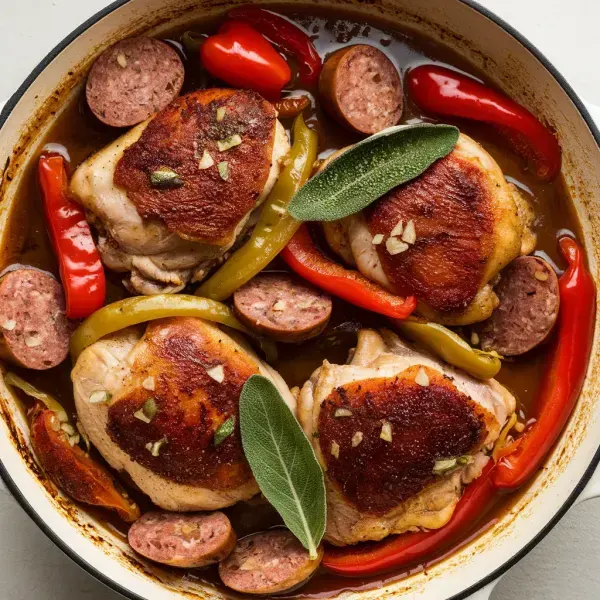
 60 minutes
60 minutesA hearty and flavorful skillet dish combining chicken thighs, Italian sausage, and vibrant vegetables in a savory sauce.


to taste
to taste
tablespoons
Sweet Or Hot Italian Sausage
0 lb
Medium Onion, thinly sliced
0 oz
Large Red Bell Pepper, thinly sliced
0 oz
Fresh Sage Leaves, finely minced
0 oz
Garlic Clove, thinly sliced
each
Pickled Cherry Peppers, thinly sliced
each
cups
Chicken Stock, low-sodium
cups
tablespoons
1. Preheat Oven
Preheat your oven to 350°F (175°C) and adjust the oven rack to the middle position. Season the chicken thighs generously with kosher salt and freshly ground black pepper.
2. Brown Chicken
In a 4- to 5-quart sauté pan or Dutch oven, heat the vegetable oil over medium-high heat. Once the oil is shimmering, add the chicken thighs, skin side down. Cook them for about 8 minutes until the skin is well browned and crisp. Then, flip the thighs and cook for an additional 3 minutes. Transfer the chicken to a plate and set it aside.
3. Brown Sausage
Return the pan to the heat and add the Italian sausage links. Cook them until they are browned on both sides, about 1.5 minutes per side. Remove the sausages to a cutting board, slice them into 3 to 4 pieces per link, and set aside.
4. Cook Vegetables
In the same pan, add the thinly sliced onion and red bell pepper. Cook them over medium heat for about 4 minutes until they begin to soften. Stir in the minced sage leaves and sliced garlic, cooking for about 1 minute until fragrant.
5. Add Cherry Peppers and Wine
Add the thinly sliced cherry peppers along with the 1/4 cup of pickling liquid from the jar. Stir and scrape up any browned bits from the bottom of the pan. Pour in the dry white wine, cooking for about 2 minutes to let the alcohol evaporate and the flavors meld.
6. Add Stock and Sugar
Stir in the chicken stock and sugar, mixing well to combine. Return the sliced sausages to the pan, nestling them among the vegetables. Place the browned chicken thighs back into the pan, skin side up, ensuring they are partially submerged in the liquid but with the skin above it.
7. Bake in Oven
Transfer the pan to the preheated oven and bake for 30 minutes. Serve the Tuscan-Style Chicken and Sausage Skillet immediately, spooning the flavorful sauce, vegetables, and sausage around the chicken pieces.
Incorporate Spanish chorizo, a selection of seafood such as mussels, clams, and prawns, and substitute the white wine with a splash of sherry. Add smoked paprika for that authentic Spanish flavor and serve with crusty bread.
Swap out the sausage for chickpeas, use a mix of bell peppers for the vegetables, and add a dash of lemon juice and zest at the end. Serve with a sprinkle of feta cheese and fresh parsley.
Replace the Italian sausage with Andouille sausage and add shrimp in the last few minutes of cooking. Use Cajun seasoning, swap out the kale for okra, and use a can of diced tomatoes as the cooking liquid for a New Orleans twist.
Eliminate the meat and double up on white beans and veggies like zucchini and eggplant. Use vegetable stock as the cooking liquid and add a splash of balsamic vinegar for depth.
Use beef as the primary protein, deglaze with red wine, and include Herbes de Provence for seasoning. Mix in olives and serve with a side of ratatouille.
Source the best quality chicken and sausage you can find. For chicken, look for organic or free-range for the best flavor and texture. For sausage, choose one with a good mix of spices and a nice fat content for juiciness—Tuscan sausage is ideal, but any good-quality Italian sausage can work.
After searing the meat, deglaze the pan with a good quality white wine, scraping up any browned bits (fond) from the bottom of the pan. This not only prevents burning but also incorporates those rich flavors into the sauce.
Don't rush the searing process. The goal is to develop a deep golden-brown crust on both the chicken and the sausage, which contributes to the final flavor through the Maillard reaction. Use a cast-iron skillet or a heavy-bottomed pan to ensure even heat distribution and a good sear.
Simmer the dish gently to allow the flavors to meld and the chicken and sausage to become tender. The sauce should be thick enough to coat the back of a spoon, so let it reduce if it's too thin.
Develop a flavor base by sautéing onions and garlic until they're just turning golden. This sweetness will underpin the dish and should not be rushed. Be careful not to burn the garlic, as it will introduce bitterness.
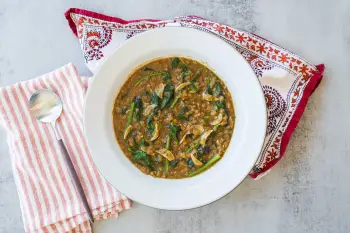
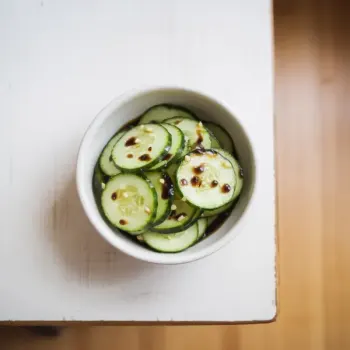
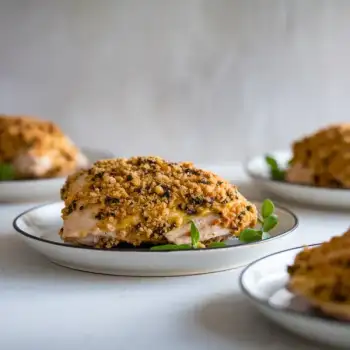
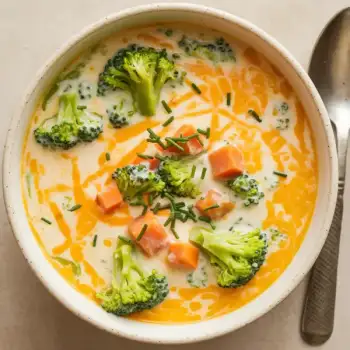
Comments (0)